Driving from Ajijic and Arriving in San Miguel de Allende, Mexico: Cornfields, Transcendence, and a Nice, Planned Housing Development
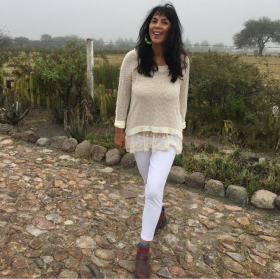 As we left the tropical splendor of the Ajijic area and drove generally east, it didn’t take long to be surrounded by farmland. Gently rolling hills dotted with trees reminiscent of Northern California chaparral lightly embraced vast, shallow valleys covered mainly with immense cornfields.
As we left the tropical splendor of the Ajijic area and drove generally east, it didn’t take long to be surrounded by farmland. Gently rolling hills dotted with trees reminiscent of Northern California chaparral lightly embraced vast, shallow valleys covered mainly with immense cornfields. Consistent with a recurring theme for much of our road trip through Mexico, what we encountered on our drive from Ajijic through the Central Mexican Highlands was completely different than what you would expect when you imagine driving through Mexico-- the roads were good, the traffic was light, the temperature was in the high 60s to low 70s, and there were very few people anywhere to be seen. White, puffy clouds bejeweled the sky. Every once in a while, after literally miles of almost uninterrupted fields, we would see a small village on a nearby hill, but that was pretty much it. Other than that, from what we could tell, most of this part of central Mexico is essentially empty. There are an awful lot of incipient tortillas out there.
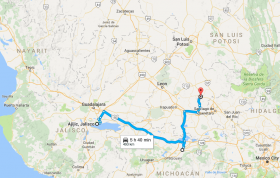
Several people recommended to us to visit Morelia along the way, which is why, on the nearby map, you’ll see an area where we drove almost due south for a short while, and then doubled back to the north to continue our route to San Miguel de Allende. At the bottom of that foray is the city of Morelia. We were told to visit the downtown area, which would amaze us with its high-end shopping and sophisticated mien.
From what we could tell, it did have some tony shops, refined eateries and nice architecture to enjoy, but it was also filled with cars; lots of cars, and these cars were going very slowly, in extremely heavy traffic. As people walking by easily passed us and we crawled along for roughly half an hour in traffic sludge, we duly noted the refined shopping from the seats of our van, then turned north and left as quickly as we could, which, because of the traffic, was not very quickly at all.
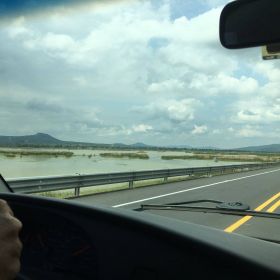
Morelia has a city center it would be better to visit on foot, after parking or being dropped off somewhere else or perhaps having a residence in the middle of it. It was a 2-½ hour detour we wouldn’t do again. Once again returning to our main travel arc basically north and east, we were happily reunited with the gently rolling, open fields where we could breathe easily on open roads, edged with vast harvests of corn and marshlands with flocks of birds picnicking in the shallow water.
A few hours later, we approached San Miguel de Allende. Even though it is only 170 miles as the crow flies from Ajijic, driving to San Miguel de Allende was like leaving in September and arriving in November. The air was markedly drier, crisper and cooler, and the terrain and foliage took on the look of a high desert. Gone was much of the tropical feel we had become so accustomed to. The mountains became rounder and browner, the large leafed trees were absent and replaced by scrub, and the density of vegetation decreased.
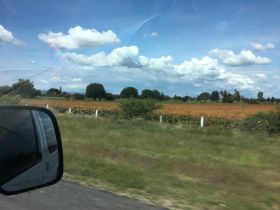 If you’re like me, when you’ve looked forward to visiting a place and studied and thought about it for a while, you have some preconceived notions of how it will actually be when you’re really, finally there. This is especially true of any place that has a famous landmark uniquely associated with it. And then, when you finally see that landmark for yourself, you have to take a beat to appreciate the entire experience, including the thankfulness you feel for seeing it in person.
If you’re like me, when you’ve looked forward to visiting a place and studied and thought about it for a while, you have some preconceived notions of how it will actually be when you’re really, finally there. This is especially true of any place that has a famous landmark uniquely associated with it. And then, when you finally see that landmark for yourself, you have to take a beat to appreciate the entire experience, including the thankfulness you feel for seeing it in person. I took that beat when, after a bend in the road, I first laid eyes on the famous Parroquia of San Miguel de Allende. As we completed the final part of our journey that day, coming in from the west around sunset, it appeared, centered in the town, several miles away. Even from that distance, the Parroquia of San Miguel de Allende conjures up wonder and admiration for the indigenous bricklayer and self-taught architect Zeferino Gutierrez who is credited with designing the look that, more than 100 years later, we can all enjoy and be inspired by.
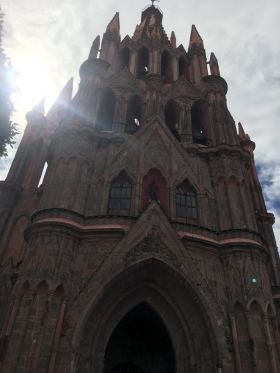 One of the things I have enjoyed most during our road trip is visiting the churches and attached town squares that are part of pretty much every Mexican city, town or village, irrespective of how few the inhabitants or how humble their resources. To me, these areas are testimonials to the aspirations of the people of that area, of their yearning and their very hard work and contribution of time and treasure to build something beautiful and lasting as a commemoration of their civic life and pride that will exist long after they are gone. Regarding the churches themselves, I would assume that one of the objectives of those who designed, funded and built the colonial churches of Mexico, or churches in any place, at any time, is to evoke a feeling of transcendence, of being closer to the heavens, and to ascend spiritually from the profane to the holy. That, they have done with the Parroquia de San Miguel Allende. It is a work of art.
One of the things I have enjoyed most during our road trip is visiting the churches and attached town squares that are part of pretty much every Mexican city, town or village, irrespective of how few the inhabitants or how humble their resources. To me, these areas are testimonials to the aspirations of the people of that area, of their yearning and their very hard work and contribution of time and treasure to build something beautiful and lasting as a commemoration of their civic life and pride that will exist long after they are gone. Regarding the churches themselves, I would assume that one of the objectives of those who designed, funded and built the colonial churches of Mexico, or churches in any place, at any time, is to evoke a feeling of transcendence, of being closer to the heavens, and to ascend spiritually from the profane to the holy. That, they have done with the Parroquia de San Miguel Allende. It is a work of art. One of the objectives of our road trip is to experience firsthand the different ways expats live abroad. Consistent with this objective, we checked into Los Labradores, a planned, gated community complete with guards at the entrance and located in the countryside (what the locals would call the “campo”), about a 15-minute drive from San Miguel de Allende centro.
Everything was very nice, very clean and very orderly. The architecture of domes, arches and miradors evoked the style found in the famous and iconic city center. There were several thermal water fed pools, a hotel, perfectly landscaped and varied gardens,  smaller villas encircling several manmade ponds, fountains and aqueduct waterfalls, and areas with larger homes facing larger manmade ponds with bridges, spillways and streams. (You can see a video of some of the pools in Rancho Los Labradores here.) There was a restaurant on-site as well as a gym and a tennis court. There were even rooms to create your artwork, a meeting room, and stables for your horses. It’s exactly what you would expect from a very well thought out and very well executed planned community.
smaller villas encircling several manmade ponds, fountains and aqueduct waterfalls, and areas with larger homes facing larger manmade ponds with bridges, spillways and streams. (You can see a video of some of the pools in Rancho Los Labradores here.) There was a restaurant on-site as well as a gym and a tennis court. There were even rooms to create your artwork, a meeting room, and stables for your horses. It’s exactly what you would expect from a very well thought out and very well executed planned community.
 smaller villas encircling several manmade ponds, fountains and aqueduct waterfalls, and areas with larger homes facing larger manmade ponds with bridges, spillways and streams. (You can see a video of some of the pools in Rancho Los Labradores here.) There was a restaurant on-site as well as a gym and a tennis court. There were even rooms to create your artwork, a meeting room, and stables for your horses. It’s exactly what you would expect from a very well thought out and very well executed planned community.
smaller villas encircling several manmade ponds, fountains and aqueduct waterfalls, and areas with larger homes facing larger manmade ponds with bridges, spillways and streams. (You can see a video of some of the pools in Rancho Los Labradores here.) There was a restaurant on-site as well as a gym and a tennis court. There were even rooms to create your artwork, a meeting room, and stables for your horses. It’s exactly what you would expect from a very well thought out and very well executed planned community. Of course, I have met more than a few expats who would recoil in horror at the prospect of living in a planned, gated community in Mexico.
“What’s the point of leaving the US?” they would ask.
“Why go to Mexico to live with a bunch of Gringos?” another may ask theoretically, their opinion based on incorrect information.
“You’re walling yourself off from the whole Mexican experience!” yet a third may yell in open disgust.
Even in the face of all this, we have a confession to make: we liked it.
At least in the case of Los Labradores, living in a planned community in Mexico is no more “walling yourself off” from Mexicans and Mexican culture than living in a planned community in the US is walling yourself off from Americans and American culture. A 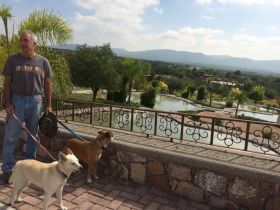 planned community is just different Mexicans / Americans and a slightly different Mexican / American culture.
planned community is just different Mexicans / Americans and a slightly different Mexican / American culture.
 planned community is just different Mexicans / Americans and a slightly different Mexican / American culture.
planned community is just different Mexicans / Americans and a slightly different Mexican / American culture. The people we met there (expats and Mexicans alike) said that, though they wanted to enjoy what San Miguel de Allende had to offer, they wanted to do so from a place that was less noisy, aromatic, and crowded with people and traffic.
And let’s be honest. Everything in Los Labradores worked pretty much all the time, and when it didn’t, the management company was there to fix it. It was quiet, the trash was picked up, and everyone had beautiful homes and grounds. The gardens were trimmed and the birds sang.
What’s not to like?
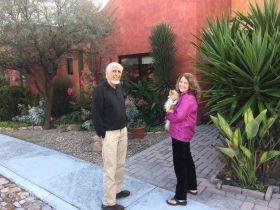 As to the charge that Los Labradores didn’t afford the “real” Mexican experience, this isn’t true, unless by “real Mexican experience” you mean the experience of living amongst the lower socio-economic classes, most of whom, I would assume, would jump at the chance to live in a planned development and escape their own "real" experience. The owners of Los Labradores are Mexican, as was our next-door neighbor and the people across the street. All in all, about half or more of our neighbors were Mexicans. They were just upper middle-class or wealthy Mexicans, all who enjoyed living in a planned community, just like there are many upper middle-class Americans in the US who like their US planned communities. In addition, in the five weeks we stayed at Los Labradores, we have never met a more kind, interesting, thoughtful group of people, expats and Mexicans alike.
As to the charge that Los Labradores didn’t afford the “real” Mexican experience, this isn’t true, unless by “real Mexican experience” you mean the experience of living amongst the lower socio-economic classes, most of whom, I would assume, would jump at the chance to live in a planned development and escape their own "real" experience. The owners of Los Labradores are Mexican, as was our next-door neighbor and the people across the street. All in all, about half or more of our neighbors were Mexicans. They were just upper middle-class or wealthy Mexicans, all who enjoyed living in a planned community, just like there are many upper middle-class Americans in the US who like their US planned communities. In addition, in the five weeks we stayed at Los Labradores, we have never met a more kind, interesting, thoughtful group of people, expats and Mexicans alike. And, we were able to visit San Miguel de Allende centro and the surrounding areas very easily. More about what it's like to be in and experience the famous expat destination of San Miguel de Allende centro in the next article.
See links to all Mexico road trip stories below. You are currently reading the one highlighted with the yellow background.
To see hundreds of questions answered by expats already living in Mexico, click here.
To see hundreds of questions answered by expats already living in Mexico, Panama, Belize, Nicaragua and Portugal, go here and navigate to the place you're most interested in.
Sign up for the Best Places in the World to Retire newsletter. To see additional additional pictures and videos not in the stories, follow us on Facebook. To see more videos of the trip, see our YouTube channel.
Want online, interactive help finding the best place abroad for you? Try the Location Advisor.
To download free research studies conducted with over 1,000 expats currently living in Mexico, click here.
Download the free eBook of all the stories below, "Our Year on the Road & Living in Mexico-- Adventures, Challenges, Triumphs, Lessons Learned"
Links to Mexico Road Trip stories:
Editor’s note: you may freely reprint the article above, provided you put this at the beginning or end:
Content provided by Best Places in the World to Retire, which provides credible answers to questions about moving abroad, expat stories, and a location advisor to help you find the perfect place for you.
Content provided by Best Places in the World to Retire, which provides credible answers to questions about moving abroad, expat stories, and a location advisor to help you find the perfect place for you.



.png)